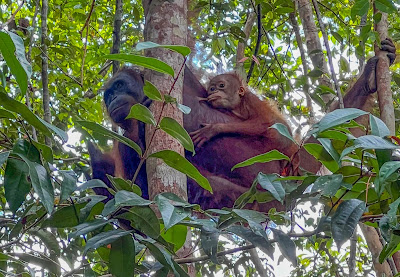The Bornean orangutan is found only on the Island of Borneo, in the states of Sarawak and Sabah, part of the country of Malaysia and in the provinces of West, Central and East Kalimantan, part of the country of Indonesia.
 |
| Borneo is the island with green on it. The green is portions of Borneo with orangutans. The northeastern portion is Malaysian Borneo and the rest is Indonesian Borneo. From Wikipedia. |
The Bornean orangutan is slightly larger than the Sumatran orangutan. It has gray skin, coarse and shaggy reddish fur. Fur does not cover its entire face, but it does have hair on the face, including a beard and mustache. It has fatty cheek pads known as flanges and a large throat sac. Males have: (a) larger flanges which are composed of muscle and mostly fat; females smaller flanges are composed mostly of muscle; (b) males have a more pronounced beard and mustache; and (c) the male's throat sac is considerably larger.
Bornean orangutans are more solitary than Sumatran orangutans and spend less time in trees than their Sumatran relatives. They also have not been observed using tools, while their Sumatran relatives have.
It is listed as Critically Endangered by the IUCN, like its Sumatran relative, but there are ten times more of them, roughly 105,000.
We flew from Jakarta, Java, to Pangkalan Bun in Central Kalimantan near the south/central tip of Borneo. From there we were driven to Kumai where we got on a klotok, a wooden Indonesian two level boat with a shallow draft. The first day we sailed from Kumai, down the Kumai River to the Sokonyer River, where we entered Tanjung Puting NP, then up to Harapan Feeding Center, known as Camp 1. On the way we saw three wild orangutans along the side of the river. In this part of Borneo, orangutans that show up at the camps for food are not referred to as wild orangutans, even though they are wild, I guess because they are more habituated to humans. It was difficult to get good photos of them.
 |
| Poor photo of a wild orangutan along the Sekonyer. |
At Camp 1 there was a platform where they deposited bananas at 4:00 p.m. for the orangutans. We saw an estimated 12 to 16 orangutans there, many of them mothers with babies and one large male that dominated the platform (eating more bananas than the others and the others showing fear of him and/or staying out of his space).
 |
| Male (note large flanges) with young female. |
 |
| Note large sac on throat. |
 |
| Female sitting on tree limb. |
 |
| Mother with baby on feeding deck. |
 |
| Mother with baby in tree. |
We stayed that night at the Rimba Lodge, just off the Sekonyer River, about a quarter-mile beyond Camp 1. The next morning we sailed further up the Sekonyer River to Pondok Tanggui, also known as Camp 2, where we went to another feeding platform for the orangutans. We saw fewer orangutans there, about 7, dominated by a female.
 |
| The dominant female hogging the bananas. |
 |
| A brave young female dared to go on the platform and eat in the vicinity of the dominant female. |
 |
| A mother, with a small baby clinging to her back, very reluctantly and carefully came to the platform while holding on to a vine, with a foot, as an escape vehicle. She grabbed bananas which she held in her mouth and one hand and then swung away from the platform. |
 |
| Another mother, with a much large baby clinging to her back and another female approached the platform from the jungle. |
 |
| They eventually climbed the platform, cowering in a corner and warily ate bananas, while huddled together, under the gaze of the dominant female. |
On the way back out, on a wooden boardwalk, we encountered a young male named Atlas who blocked our way. We watched Atlas for quite a while and then carefully walked around him to get back to the Klotok.
We traveled further upriver and got to Camp Leakey, also known as Camp 3. There we saw about 8 orangutans being fed at the wooden feeding platform.
 |
| A dominant male with large flanges and large throat sac hogs the feeding platform. He eats more bananas than all of the other orangutans combined. |
 |
| A mother, with a clinging baby, walked right past us up to the platform. |
 |
| This mother and baby came to the platform from a tree. |
We traveled back to Rimba Lodge where we spent the night, then got up early the next morning and back out to to Kumai. We saw another 3 or 4 wild orangutans along the Sekonyer River from Camp Leakey on the way out.
 |
| A wild orangutan in a tree, seen from the boat. |



































I loved the mothers with the babies hanging on to them--on their chest, backs, arms, anywhere they could get hold. They seem to hang onto Mom until they are fairly old. And those photos of the dominant male who hogged much more than his share of the bananas--Doesn't he look like Jabba the Hut?
ReplyDelete